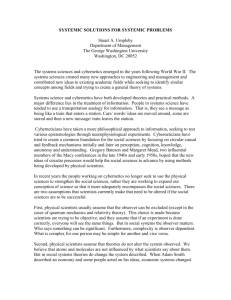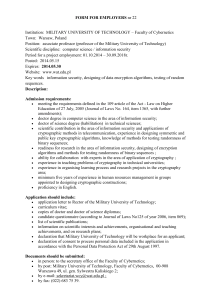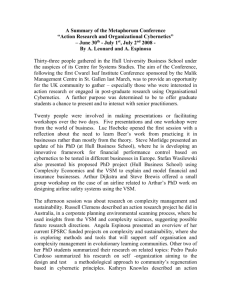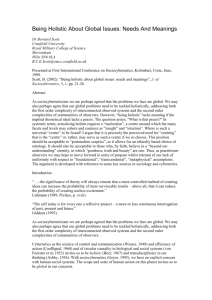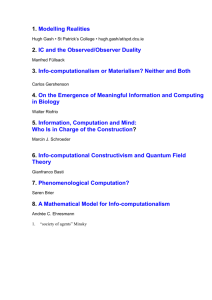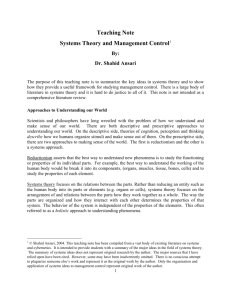Seeking the Embodied Mind in Video Game Theory: Embodiment in
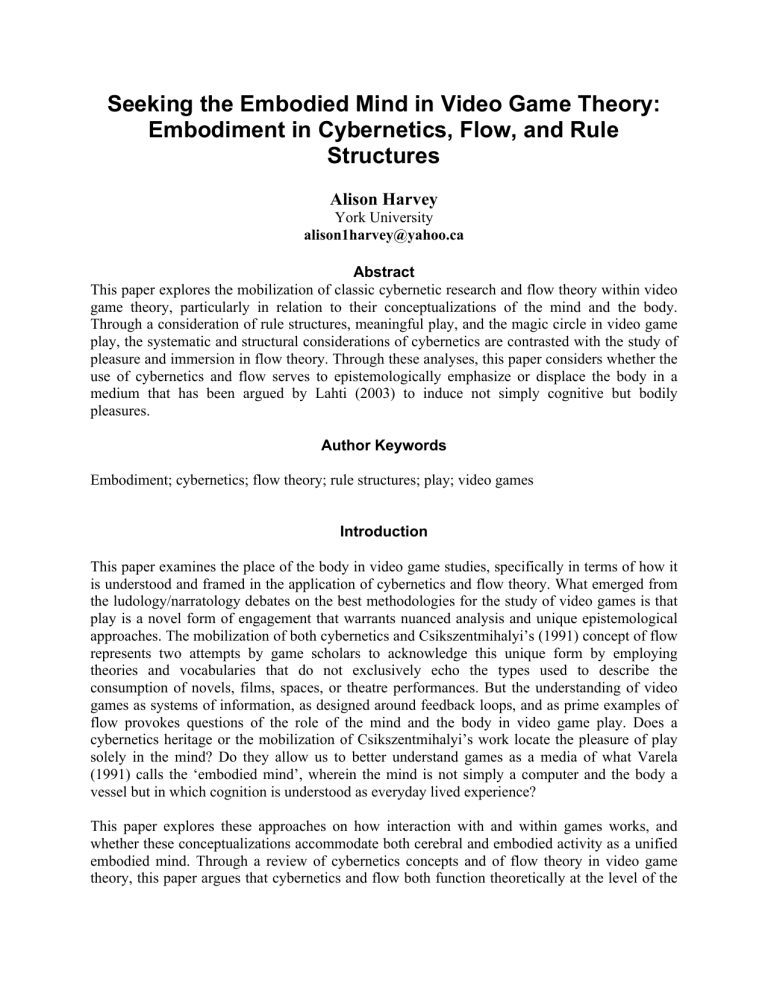
Seeking the Embodied Mind in Video Game Theory:
Embodiment in Cybernetics, Flow, and Rule
Structures
Alison Harvey
York University alison1harvey@yahoo.ca
Abstract
This paper explores the mobilization of classic cybernetic research and flow theory within video game theory, particularly in relation to their conceptualizations of the mind and the body.
Through a consideration of rule structures, meaningful play, and the magic circle in video game play, the systematic and structural considerations of cybernetics are contrasted with the study of pleasure and immersion in flow theory. Through these analyses, this paper considers whether the use of cybernetics and flow serves to epistemologically emphasize or displace the body in a medium that has been argued by Lahti (2003) to induce not simply cognitive but bodily pleasures.
Author Keywords
Embodiment; cybernetics; flow theory; rule structures; play; video games
Introduction
This paper examines the place of the body in video game studies, specifically in terms of how it is understood and framed in the application of cybernetics and flow theory. What emerged from the ludology/narratology debates on the best methodologies for the study of video games is that play is a novel form of engagement that warrants nuanced analysis and unique epistemological approaches. The mobilization of both cybernetics and Csikszentmihalyi’s (1991) concept of flow represents two attempts by game scholars to acknowledge this unique form by employing theories and vocabularies that do not exclusively echo the types used to describe the consumption of novels, films, spaces, or theatre performances. But the understanding of video games as systems of information, as designed around feedback loops, and as prime examples of flow provokes questions of the role of the mind and the body in video game play. Does a cybernetics heritage or the mobilization of Csikszentmihalyi’s work locate the pleasure of play solely in the mind? Do they allow us to better understand games as a media of what Varela
(1991) calls the ‘embodied mind’, wherein the mind is not simply a computer and the body a vessel but in which cognition is understood as everyday lived experience?
This paper explores these approaches on how interaction with and within games works, and whether these conceptualizations accommodate both cerebral and embodied activity as a unified embodied mind. Through a review of cybernetics concepts and of flow theory in video game theory, this paper argues that cybernetics and flow both function theoretically at the level of the
rule structure of video games, which does not fully account for embodied play. The conclusion of this paper considers how the field needs to move beyond the supplanting of the body in theories of technologies to better understand the role of the corporeal, the material, and the physical in the medium of the video game.
Cybernetics, Ludology, and the Video Game as an Informational System
Lahti (2003) notes that the video game has become “a paradigmatic site for producing, imagining, and testing different kinds of relations between the body and technology in contemporary culture” (p.158). This is of central importance considering that many body scholars have noted a general scholarly tendency towards segregating and compartmentalizing the mind and the body in both theory and practice (Grosz, 1994; Synnott, 1993). The focus of communication theory and media studies has been the cognitive processes of meaning-making.
The body has been introduced largely in postmodern cultural studies that emphasize feminist, queer, and postcolonial identities and epistemologies (Haraway, 1991; Butler, 1990; Adam,
1995; Kember, 1996). It is thus central to consider whether the relatively young and developing field of video game theory is succumbing to a dichotomous understanding of the body and the mind, or whether theories of game play are providing new insights into the everyday experiences of the embodied mind. Cybernetics as a field focuses on cognition, particularly through the concept of feedback loops. Its application must be probed for its implications in the theorization of game play.
The roots of cybernetics in video game theory lie in Aarseth’s (1999) proposal of video games and other new media texts as ‘cybertexts’, which is directly informed by Norbert Weiner’s
(1948) basic definition of cybernetics. Cybertext does not refer to cybernetics beyond Weiner, including the developments in the field to this day that have addressed the body more rigorously, including robotics and contemporary artificial intelligence research. However, based only on
Weiner’s earliest observations, Aarseth argues that the mechanical organization of the text is the central element of its literary exchange, and that informational feedback loops characterize these novel texts, including video games. Feedback in classic cybernetics is seen as present when “a circularity of action exists between the parts of a dynamic system” (Ashby, 1956, p.31). The term has encountered debate, but the basic meaning of feedback is of two parts affecting each other.
For Aarseth, the user of the cybertext differs from the reader of a traditional text because her performance is extranoematic, which means that it is outside the boundaries of human thought.
This work, involving the navigation of textual possibilities, and is argued (problematically by some) to be physical, nontrivial, and significant beyond the work entailed by reading. Though it would seem that this directly implies embodied action, Aarseth is referring to extranoematic work only in comparison to what is framed as linear consumption of non-hypertexts, such as traditional novels. What is proposed as physical and nontrivial work in the cybertext is the user’s cognitive grappling with the limitations and the possibilities offered in the text. These choices mean that the cybertext user is more than a spectator; she is a participant who must take risks, get lost, explore, and discover. The argument is for a different spatio-dynamic metaphor in discussions of new media forms; Aarseth posits the need for a labyrinthine trope that supplants a
2
linear conception and captures the critical choices the user makes in selecting some options and rejecting others.
Though cybernetics and the feedback loop are evoked in the introduction to Aarseth’s book and in the neoteric label of ‘cybertext’, neither concept returns in the analysis of these new media forms, nor are feedback loops ever explicitly defined or considered for their epistemological underpinnings. Aarseth defines cybertext as the site of cyborg aesthetics, wherein control of meaning is fought for by the author, the text, and the reader. Cybertexts reject the ideological
Author and the attendant implications of authorship and instead focus on ‘cyborg-author combinations’. Overall, Aarseth never directly addresses the body or the material or physical aspects of interacting with cybertexts. The body takes on a secondary role, as the reading of a cybertext may result in an unsuccessful engagement that can entail frustration, rejection, anger, and impatience, which can in turn lead to the player physically, emotionally, and intellectually abandoning the video game. Aarseth’s analysis emphasizes the struggle for textual mastery and a sense of control over the elusive enigma of the correct form of perception required by a particular text. Thus, the implication of the roots of game theory in cybernetics is not clarified in
Aarseth’s work. His conception of the way the machine and the human interact in new media forms requires an investigation of some foundational concepts for a greater understanding of what the evocation of cybernetic feedback loops entails.
Cybernetics is the science of control and communication. The field emphasizes the everyday, behavioural actions of machines and systems, and the analysis of coordination, regulation and control in both biological and mechanical systems. The definition of feedback loops in cybernetics (two parts mutually impacting one other) aligns with Aarseth’s conceptions of preprocessing, co-processing, and post-processing. In the case of the video game, action circulates between the human and the machine, when the creators code virtual environments, when the player runs through a level, and when the gamer fails or succeeds at a game.
It is important to note that the application of feedback loops as a concept entails further adoption of other cybernetics doctrines. As Ashby (1956) states, any consideration of the basic principles of dynamic systems requires more than a conception of feedback. What is needed is an understanding of how complex behaviours in systems can feature goal-seeking actions in intricate patterns. Evoking classic feedback loops as defined by Weiner also evokes very particular understandings of information, regulation, stability, and behaviour, and thus implies very mechanistic structures that operate with an absence of ambiguity. The emphasis in cybernetics is, at its origins, machine-like. This follows in Aarseth’s emphasis on textual mechanics. Though Aarseth postulates a different form of engagement, his conception of cybertext is epistemologically entrenched in intellectual rather than embodied , corporeal , or material pleasures, challenges, risks, and experiences. Thus, underpinning ludology with cybernetics is not just theoretical but also political in its implications. The disappearance of the body is central to the posthuman computer age, according to Hayles (1999), especially in foundational cybernetics and artificial intelligence works. This occurs through the proposition of human intelligence as a property of the computational system of symbols rather than as part of our lifeworld. With the erasure of the body’s materiality comes the privileging of formal informational patterns that confound artificial and human intelligence.
3
Thus, cybernetics’ original implication of the human body is as a self-regulating system that disrupts traditional boundaries and borders, including those around the self and the machine.
This means that an intellectual concept of the human can be seen as intact even if the body is framed as mechanistic. This echoes the roots of the Cartesian dualism between the mind as the seat of humanity and the body as a machine in service of this mind. As Hayles notes, this is at the origins of information as a disembodied medium, and thus the application of early cybernetics into video game theory does carry an emphasis on disembodied interactions rather than an embodied mind, with its physical, material, kinaesthetic experiences.
The Body, the Mind, and the Pleasure of Flow
In areas such as immersion and the pleasure of playing, the experience of game play is the main focus of work broadly termed as flow theory. This work on the pleasure of play references the work of Csikszentmihalyi (1991), a psychologist who explores the characteristics of fun, happiness, satisfaction, and transcendence, and how these sensations are achieved in an activity, ranging from sports to musical performances to professional work. Csikszentmihalyi defines the moment of total immersion and pleasure in an activity as ‘flow’, and charts this moment on a graph between the axes of challenge and ability. This theory of immersion posits that the main dynamic of flow is the function of the relationship between challenge and ability, and too far a tendency on either side results in either anxiety on the one hand, or apathy and boredom on the other.
The idea of flow as an ecstatic state is not unproblematic in its perspective on the relationship of the mind and the body. One premise of this argument is that we need to condition the mind to be free of external dictates of social structures as well as of the body. Csikszentmihalyi believes that pleasure and pain reside solely in consciousness, and that the mind has the power to resist bodily repression of satisfaction. This indicates an adversarial relationship, wherein the mind conditions the body. However, when the analysis turns to the sensation of flow in particular, the adversarial relationship is inverted; Csikszentmihalyi’s thesis is that the mind must also be conditioned before we can understand and realize more physical, material, and tacit pleasures. Though there is certainly ambivalence in this understanding of the body and the mind, there is also a conception of a mutual and interlocked relationship.
Csikszentmihalyi posits that the flow we experience when playing a great game is a prime example of how we can condition other parts of our lives. Because of this, flow has become central to game theory. Good games that are responsive to player ability and game difficulty are framed as microcosms of optimal experience 1 . They give the player a sense that their skills and abilities are adequate for coping with the challenges presented, and are based around “a goaldirected, rule-bound action system that provides clear clues as to how well one is performing”
(Csikszentmihalyi, 1991, p.71). In this space, where skills and challenge are balanced, and rules guide activity, the person experiences a sensation of total concentration. The reason that welldesigned games are seen to result in flow is because they are structured around rules, goals, feedback, and expectation of particular skills, though Csikszentmihalyi notes that the commitment of the participant to engaging with the activity is also essential. Games entail the construction of a particular reality, wherein players acquiesce to the bizarre costumes of hockey
4
gear, the rituals of chess, and the arbitrary rules of the video game. Many games also entail a conscious acquiescence to the rules of the game at the moment of the physical and material entrance into a game zone, be it a playground, a football field, or the virtual worlds of Azeroth,
Raccoon City, or The Mushroom Kingdom. The terrain wherein the game or activity occurs is corporeal and material, requiring particular physical actions on top of player acquiescence and concentration. Hence, flow theory does address the mind and the body, but with some limitations and problems.
Playing with the Mind and the Body
It is clear that flow theory is not a perfect approach to bodily pleasures in video game play. With its tendency towards conceiving of the mind and the body as antagonistic, it does not entirely answer Lahti’s (2003) call to understand the experience of video game playing as a chance to reformulate the relationship between the corporeal body, the technological artefact, and human subjectivity. However, it does provide game scholars with an understanding of the required balance between challenge and skills that can help us to better understand the experience of immersion. This is particularly the case with scholars such as Lahti and Grodal (2003), who try to link cognitive, emotional, and physical interactions to game play. Though it seems as if the concepts of the stable cybernetic feedback loop in a goal-directed system and the ideas of flow as a fine balance between challenge and ability are quite distinct, they do intersect at the level of the rule structure. It is at this level that both feedback loops and the challenges described by
Csikszentmihalyi (1991) actually operate and apply to the experience of playing the video game.
In classic game theory (Huizinga, 1950; Caillois, 1967), the rule structure is what differentiates playing games such as chess from free play such as the making of sand castles. The stringency of rules in a game will dictate how game-like it is. Games that have flexible and fluid rules are more play-like. Games such as chess that require the player to consent to following the rules or risk being accused of cheating or ruining the game are deemed more game-like. Game and play are the poles of a continuum of different kinds of games, and the magic circle is the term used
(Salen and Zimmerman, 2004) to describe the unique space wherein the rules of the game in the moments of play supersede the rational rules of the real world i . As Csikszentmihalyi describes, entering into any game means accepting abstract and arbitrary rules that may override common sense outside of the game (for instance, valuing the queen in chess above all other miniature wooden pieces).
Flow theory addresses game rule structures in its emphasis on goal-oriented, rule-based systems.
This is valuable for game studies. While video games are complex media texts that can combine images, cut-scenes of video, songs, ambient sound and simple text, they are built and designed first around rules (Salen and Zimmerman, 2004). These other media elements are thus secondary to the functioning of the game and of the mediated elements that differentiate classic games like chess from their video game versions. According to Salen and Zimmerman (2004), “Every set of rules defines a game. Rules are the formal structure of a game, the fixed set of abstract guidelines describing how a game system functions” (p.117).
Activity can occur outside the rules, as in communication with other players in online games.
The extent to which this can help achieve a successful outcome depends on the open-endedness
5
of the game; for instance, how good communication can facilitate a team’s success in capturing the flag. In terms of the specific design of game goals and outcomes, the rules will determine whether your skills are adequate for the challenge, as in as the example of a healer’s skills addressing the challenge of saving team mates. The balance of skills and challenge in turn will shape the grounds for an experience of flow in the game, though there are limits because of player circumstance and agency. For instance, the rules cannot impact whether you have poor hand-eye coordination, are exhausted, are being griefed by another team of players while trying to capture the flag, or are distracted. Thus, assenting to the rules of the game does not necessarily entail acquiescing to flow. This is one way that the corporeal, the emotional, and the mental faculties of the player may not align, which shows how all become necessary to game play. In a game like World of Warcraft, the success of running an instance will be dependent on external factors, such as hunger, tiredness, anxiety, and technological failure, as well as internal factors, such as group cohesion, gear and avatar skills. All would need to align to create flow. This balancing act between player agency and structured play is addressed through considerations of meaningful play. This is the design term Salen and Zimmerman (2004) use to refer to the need for game designers to reconcile the freedom required in video games (such as exploration of terrain, and choice of activities) and the constraints required to provide challenge for the players
(such as the rule structures that determine difficulties the player must overcome).
Flow is explicitly linked to rule structures in its emphasis on rules, goals, and play spaces, but what about cybernetic feedback loops? This mechanistic approach is not as flexible in its application, but it can refer to the specifically technological elements of game play. This is in opposition to flow, which does not explicitly capture game play on computers or consoles, but all forms, like classic game theory. In the simple sense of two parts of a system that impact each other, feedback loops are seen by Salen and Zimmerman (2004) as a strong method of thinking about programming spaces of possibility and meaningful play in game systems. This is because thinking of games and players as systems allows game designers to consider the correct balance between uncertainty, flexibility, and information. These become important because, as Aarseth notes (1997), cybertexts entail possibility and options. As in cybernetics, designers must clamp down on too much noise through regulation in order to stave off total chaos. Chaos in the system will disrupt any kind of meaningful relationship between a player’s action and the outcome, which are central to both flow and the pursuit of goals as determined by the rule structure. This is why meaningful play is so important to designers. Their job entails staving off chaos while providing players with some sensation of flexibility and freedom within the game world.
However, the problem with primarily thinking about games through cybernetic feedback loops in their design is that this is a kind of technological essentialism that overemphasizes the system and underemphasizes the “emotional, psychological, social, cultural, and contextual factors that influence the experience of the game for the players” (Salen and Zimmerman, 2004, p. 226). In many ways, cybernetics-informed work on cyborg-author interactions might be better suited to the structural facet of video game theory, while other approaches should be employed to examine other elements, experiences, and dimensions of the medium.
6
Conclusions
This review has highlighted that neither flow theory nor cybernetics influences in game theory serve to enact entirely unproblematic conceptions of corporeal and intellectual engagements with games. Upon examination, both are located in a very specific space of game play—the formalist structures of rules that order the internal mechanics of the game for the player, and which do not account for the intersections of a variety of other factors in play. Neither approach explicitly deals with material or embodied engagements with play, though it is evident to anyone who has ever played a game that these engagements are essential. A flow of the mind, the emotions, and the physical self are required to fully enter the flow channel, the magic circle of the rules, and meaningful play, yet epistemological origins in game studies continue to position a dichotomous and antagonistic relationship between the mind and the body. The body and materiality that is absent in these theories is evident when actually engaging with games, from the way the heart races when playing a fast-paced first-person shooter to the obvious physicality of taking part in
Rock Band, Dance Dance Revolution, or Wii Sports. It is also central to both the context of gaming and the ways in which players as embodied may be blocked from gaming (for instance, gendered differences in access, perceived preferences, marketing, content, and culture- see Carr,
2005). Thus the quest for integrating the body in video game theory must continue, because even some of the most compelling depictions of its organizing structures, cybernetics and flow theory cannot fully account for the embodied nature of video game play.
One fruitful avenue for furthering game studies with an emphasis on the embodied mind is considering the material aspects of playing with sociotechnical artefacts (Giddens, 2007), from the body of the player to the technological networks in which they engage to the challenges of access entailed by games in the home. Just as play is not simply a cognitive experience, players as embodied carry into engagements with games their gender, race, contexts, and experiences.
Video game theory needs to account for networks of the player and the game to better understand the role of context and agency when discussing flow, rule structures, feedback loops, and the magic circle. None of these concepts can be held as sacrosanct and immutable when considered in light of embodied play. As this investigation has revealed, we need to foreground the body in light of the epistemological disavowal of corporeal differences, pleasures, and challenges revealed in cybernetics (Hayles, 1999) and the adversarial conception of the body and the mind in flow theory. We need to actively pursue an account of video games that will explain “the feeling that our bodies and minds have extended into this virtual space and that the space of the real and virtual are joined” (Gee, 2007, p.18).
7
References
Aarseth, E. (1999.) Cybertext: Perspectives on Ergodic Literature. Baltimore: John Hopkins
University Press.
Adam, A. “Embodying Knowledge: A Feminist Critique of Artificial Intelligence." European
Journal of Women’s Studies 2 (3).
Ashby, R. W. (1956.) An Introduction to Cybernetics. London: Chapman & Hall. Retrieved from http://pcp.vub.ac.be/books/IntroCyb.pdf
Butler, J. (1990.) Gender Trouble: Feminism and the Subversion of Identity. New York:
Routledge.
Caillois, R. (1967.) Les jeux et les hommes: Le masque et le vertige. Paris: Gallimard.
Carr, D. (2005.) “Contexts, Gaming Pleasures, and Gendered Preferences.” Simulation and
Gaming 36(4).
Castronova, E. (2005.) Synthetic Worlds: The Business and Culture of Online Games. Chicago:
University of Chicago Press.
Csikszentmihalyi, M. (1991.) Flow: The Psychology of Optimal Experience. New York: Harper
Perennial.
Gee, J. P. (2007.) “Video Games and Embodiment.” American Educational Research
Association Conference. http://inkido.indiana.edu/aera_2007/aera_gee.pdf
Retrieved from
Giddens, S. (2007.) “Playing with Non-Humans: Digital Games as Technocultural Form.” In De
Castell, S & Jenson, J. (Eds.) Worlds in Play: International Perspectives on Digital
Games Research. New York: Peter Lang.
Grodal, T. (2003.) “Stories for Eye, Ear, and Muscles: Video Games, Media, and Embodied
Experiences.” In M.J.P. Wolf & B. Perron (Eds.), The Video Game Theory Reader. New
York: Routledge, p. 129-155.
Grosz, E. (1994.) Volatile Bodies: Toward a Corporeal Feminism. Bloomington: Indiana
University Press.
Haraway, D. (1991.) Simians, Cyborgs, and Women. London: Free Association Books.
Harvey, A. (2007.) “You Mean It’s Only a Game? Rule Structures, the Magic Circle, and Player
Participation in Pervasive Mobile Gaming.” Loading…Journal of the Canadian Game
Studies Association, 1(1).
8
Hayles, K. (1999.) How We Became Post-Human: Virtual Bodies in Cybernetics, Literature, and
Informatics. Chicago: University of Chicago Press
Huizinga, J. (1950.) Homo Ludens: A Study of the Play Element in Culture. Boston: Beacon
Press.
Kember, S. (1996.) "Feminism, Technology and Representation." In D. Morley and V.
Walkerdine (Eds.) Cultural Studies and Communication. London: Arnold.
Lahti, M. (2003.) “As We Become Machines: Corporealized Pleasures in Video Games”. In
M.J.P. Wolf & B. Perron (Eds.), The Video Game Theory Reader. New York: Routledge, p. 157-170.
Salen, K. & Zimmerman, E. (2004.) Rules of Play: Game Design Fundamentals. Cambridge:
MIT Press.
Synnott, A. (1993.) The Body Social: Symbolism, Self and Society. New York: Routledge.
Taylor T. L. (2006). Play between Worlds: Exploring Online Game Culture.
Cambridge: MIT Press.
Varela, F., Thompson, E. & Rosch, E. (1991.) The Embodied Mind: Cognitive Science and
Human Experience. Cambridge: MIT Press.
Weiner, N. (1948.) Cybernetics: Or the Control and Communication in the Animal and the
Machine. Cambridge: MIT Press.
1
See Taylor (2006) for a discussion of the problem of emphasizing flow too strongly or exclusively. She argues that the flow channel is too narrow and easy to fall out of, and notes the importance of social, exploratory, and immersive aspects that allow for player enjoyment.
2
There are instances that the sanctity of the magic circle has been troubled or countered- in the economics of virtual worlds, the practices of professional gaming, and the play of urban games, for instance. See Castronova (2005), Taylor (2006), and Harvey
(2007) for more on these moments.
9

